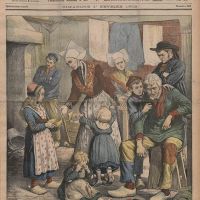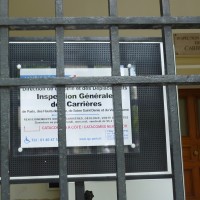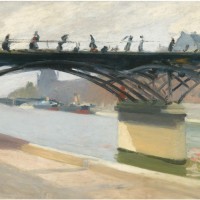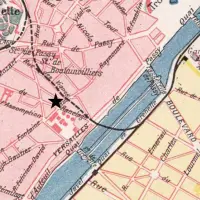On our last two trips to Paris, much of our time was spent in library research. Here is a picture that our friend Mireille took of us in the library of the Association Valentin Haüy.
It consists of one large room with books and documents on three sides in tall glass-fronted cabinets with wooden cupboards underneath, also filled with boxes of documents. The fourth wall is all windows, which open on to a quiet side street. Even in June’s heat, it was reasonably cool there.
As you can see, we are using a variety of printed and archival materials. These are not available digitally. You have to go there and look at them yourself. It is a unique collection, focused on the education of the blind, including a range of associated subjects, from linguistics to technology to fiction. We met two other researchers during our visit. One was studying the autobiographies of blind people, and the other researching the history of sounds.
We enjoyed our weekday routine of library work in the morning, lunch in the canteen, more reading, transcribing, and photographing in the afternoon, and home again with plenty of time to pick up some fresh food for dinner. We would recommend the place to you, but we cannot. The library, along with the associated museum, closed when the conservatrice responsible for both retired at the end of June. The Association is looking into ways to offer continued access to researchers, but the future of the museum and library is by no means certain.
In an earlier blog, we talked about the gradual loss of Paris bookshops. What about libraries? The much-anticipated reopening of the Labrouste reading room in the Bibliothèque Nationale de France Richelieu complex suggests that libraries are prized. But although they may seem stable, specialized libraries and archives can close quite suddenly. For example, we were told that the archives of the Quinze-Vingts (the refuge for indigent blind people founded in the 13th century, now an eye hospital) is no longer maintained or accessible.
Given the fragility of so much documentation, we were delighted at one point to find a tiny survivor of what was once a network of Parisian lending libraries.
Norman was hunting for a book that he needed for his research, and Mireille suggested we try the library of Les Amis de l’Instruction on the rue de Turenne in the 3rd arrondissement. It was open on Saturday afternoons only. Wisely, she added that even if they didn’t have the book, it would be well worth the journey there. She was right.
We nearly missed the place, with its modest sign.
Notice the words “prêt à domicile.” This was a lending library – Paris’s first.
When we found the right door, we walked through and straight into the 19th century. Two friendly volunteers ushered us into the main room, with its central table and book-lined walls.
One volunteer checked the card catalogue for the book we wanted. It wasn’t there, but at this point, we didn’t mind a bit.
They showed us around the warren of small rooms on two levels lined with floor-to-ceiling bookshelves.
The library occupies part of a much older building, which dates from the 1650s, known as the hotel de Gourges for Armand Jacques de Gourges, marquis de Vayres. He bought it in 1707, but lost the building (and his own head) during the Revolution, at which point, the house became public property. It is still owned by the City of Paris.
The library’s founder was a lithographer called Jean-Baptiste Girard, who had spent time in prison for the crime of belonging to a labour union and taking part in a demonstration. In 1861, he and a group of like-minded workers created a new type of institution: a private lending library open to all – women included.
Library users paid a membership fee (about 50 centimes a month) that gave them the right to participate in the running of the place. The library maintained a list of requests, to allow members to suggest acquisitions. Although this seems a benign sort of venture, in the 1860s, it was quite subversive. At a time when labour unions were suppressed, self-organization of this sort was frowned upon by the authorities, who would have preferred literate members of the working classes to read only materials approved by the ruling classes.
The original register of members from the time of its founding shows that its adherents included not just workers, but architects and lawyers, artists and students, and people from other parts of the city, such as Auguste Rodin. Clearly there was a demand for this kind of open access to books.
And the idea spread. At one point there were 14 of these libraries spread across the city, and one in the suburb of Asnières, offering books, lectures, and even excursions.
The books we saw all date from before 1940, when the network of lending libraries started a slow decline. Gradually, all except this one closed down. Many of the libraries that closed offered their books to the remaining library in the rue de Turenne, which accepted as many non-duplicates as possible, cramming them into every available space.
Yet quaint and anachronistic as it may sound, the library is not a time capsule. At one point, we rounded a corner to find a desk with a computer on it.
Les Amis de l’Instruction also maintain an extensive website, which includes access to taped versions of monthly talks held in the downstairs room, many of which are on the history of the city (if you are around in September 2017, there will be one on the lost river of the Bièvre). You can view old catalogues, listing books in various branches of the sciences, as well as history, geography, literature, and commerce. There are even links to free online copies of some of the 19th-century books in the collection.
Before we left, one of the volunteers took Norman’s e-mail address and offered to follow up with a friend who might know the whereabouts of the book we sought. The place is well named: its members really are the friends of instruction and knowledge. We wandered back out into the rue de Turenne, marvelling that such a fragile entity had survived for more than 150 years, hoping it would be there again on our next visit.
Text and photographs by Philippa Campsie; opening photograph by Mireille Duhen.
La Bibliothèque des Amis de l’Instruction is at 54 rue de Turenne, 3rd arrondissement, Métro Chemin Vert or Saint-Paul. It is open Saturdays from 3 to 6 p.m. or by appointment. Telephone 01.42.71.03.43 or e-mail @bai.asso.fr




























